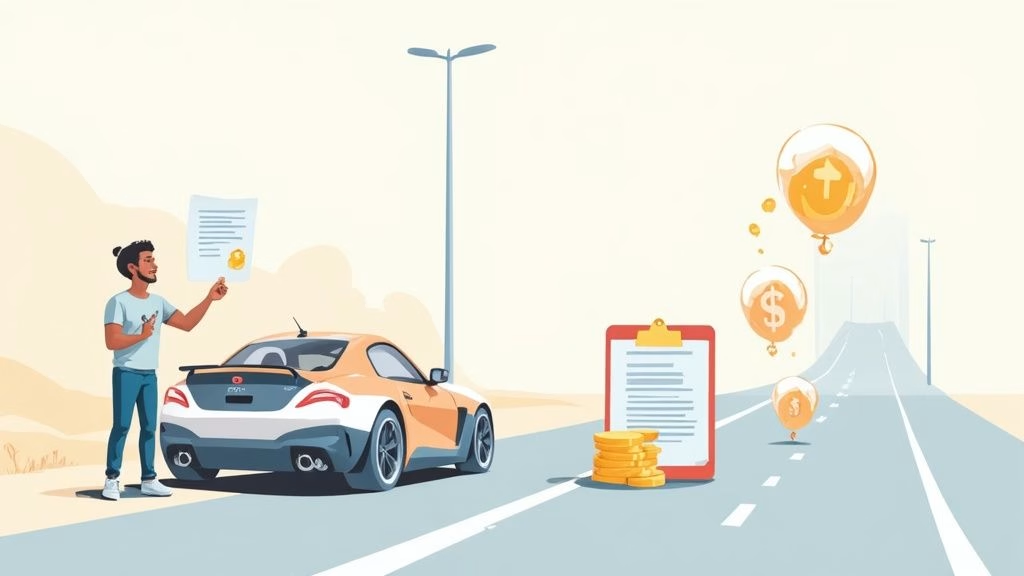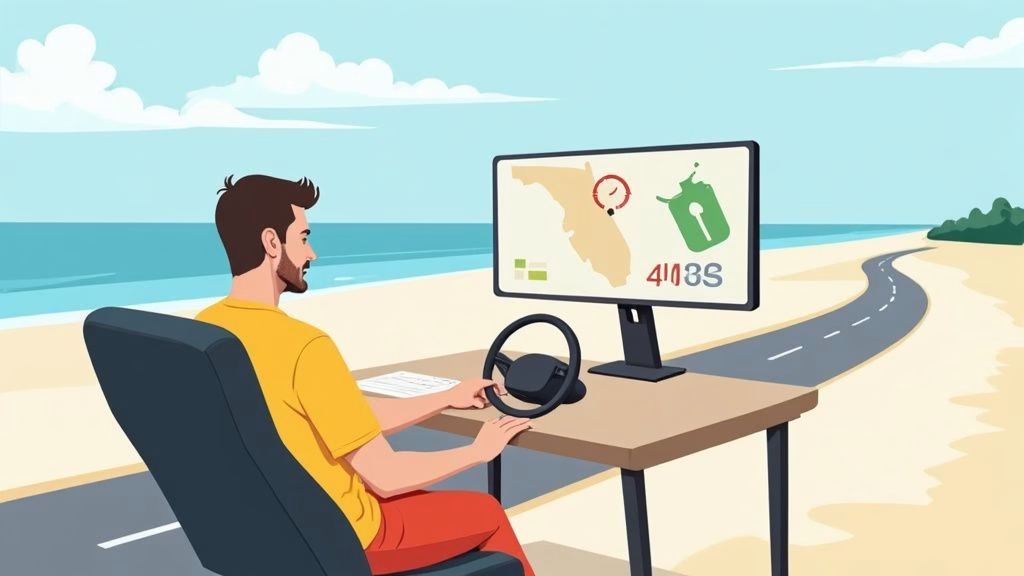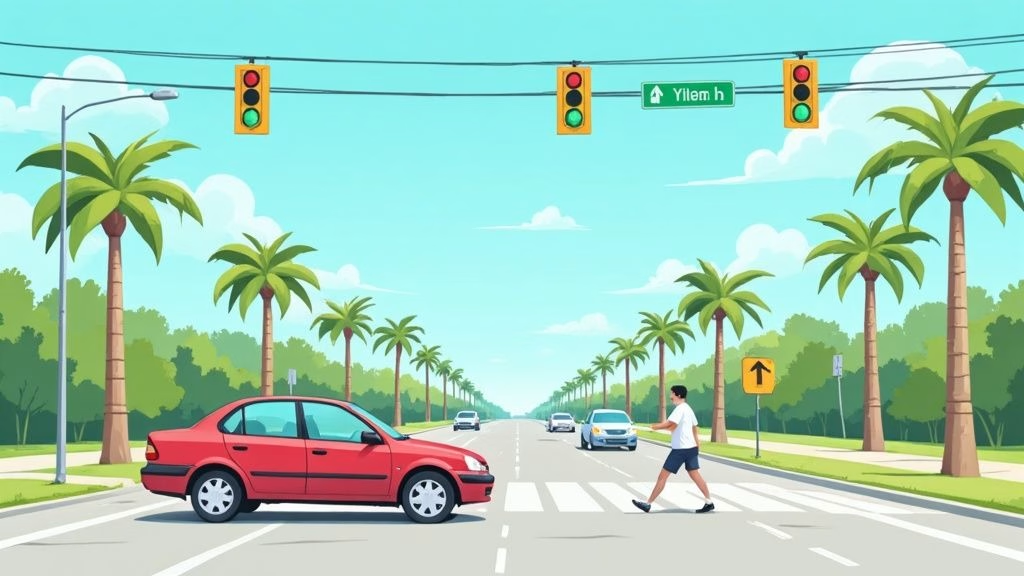Taking a safety driving course is one of the smartest, most direct ways to get a car insurance discount. When you finish an approved defensive driving program, you’re not just getting a certificate�you’re proving to your insurer that you’re a lower-risk driver. That commitment almost always translates into lower annual premiums.
This guide will walk you through exactly how that works, from finding the right course to cashing in on the discount.
How a Safety Course Lowers Your Insurance Premiums
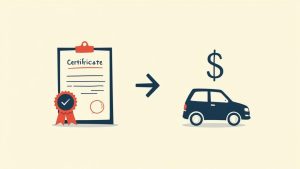
Think about car insurance from the provider�s perspective. It�s all a game of risk. They calculate your premium based on how likely they think you are to get into an accident and file a claim. A driver with a clean record is a good bet; someone with a history of tickets and fender benders is a much bigger gamble.
A safety driving course is your chance to directly influence that calculation. By completing one, you’re actively working to become a safer driver, and that�s a powerful signal to send.
The Logic Behind the Discount
Insurance companies love seeing that certificate because it�s a win-win for them. A driver who’s just refreshed their knowledge on hazard perception and defensive maneuvers is less likely to cause a costly accident. Fewer claims mean less money paid out by the insurer.
They happily pass a piece of those savings back to you as a safety driving course insurance discount to encourage this kind of proactive behavior.
The concept is simple: you invest a little time to become a safer driver, and they reward you with real, tangible savings on your policy. It�s one of the few discounts you have complete control over.
The savings aren’t just a few bucks, either. Most drivers see their premium drop by 5% to 20%, with the typical discount landing right around the 10% mark. If you want a more detailed breakdown, you can learn more about how much defensive driving can lower insurance. For most people, that makes the small cost of the course a no-brainer.
Now, let’s look at what some of the major players offer.
Typical Insurance Discount Ranges from Major Providers
Keep in mind that these are just estimates. The exact discount you’ll get depends on your state, driving record, and the specifics of your policy. But this table gives you a good idea of what to expect.
| Insurance Provider | Typical Discount Range | Common Eligibility Notes |
|---|---|---|
| Allstate | 5% � 10% | Often for drivers aged 55+ or young drivers completing teenSMART. |
| GEICO | Up to 15% | Varies by state; must complete a state-approved defensive driving course. |
| State Farm | Up to 15% | Typically for drivers under 25 or over 55; state-specific requirements apply. |
| Progressive | 5% � 10% | Varies significantly by state and driver profile; must be an approved course. |
| Nationwide | 5% � 10% | Available in most states for drivers who complete an approved safety course. |
The best first step is always to call your insurance agent. They can tell you exactly which courses are approved in your state and what kind of discount you can look forward to.
What This Guide Covers
This guide is your roadmap to unlocking those savings. We’ll dive into everything you need to know, including:
- The key skills you�ll learn that actually make you a lower-risk driver.
- Who qualifies for these discounts (it’s not just for older drivers!).
- A step-by-step walkthrough for claiming your reduced rate.
- Tips for picking the right state-approved course for you.
Of course, a safety course is just one piece of the puzzle. It�s always smart to explore additional ways to reduce insurance costs to get the best possible rate.
Let’s get you on the road to becoming a safer driver and, more importantly, saving some money.
Why Safer Driving Skills Mean Real Savings
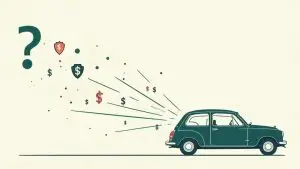
Let’s be clear: insurance companies are in the business of managing risk. When you finish a safety driving course, you’re not just getting a gold star for good effort; you’re actively lowering your risk profile. This gives your insurer a concrete, data-backed reason to charge you less.
Think of it this way. Your basic driving knowledge is like the factory settings on your phone. It works, but it isn’t optimized for today’s world. A safety course is like a software update�it gives you new tools and awareness to navigate modern traffic, technology, and hazards far more effectively.
This isn’t just a gimmick. Insurance providers have seen the data and know that drivers who complete these programs file fewer claims. By spending a few hours brushing up on your skills, you’re making a statement that you�re a safer bet, and that commitment pays off.
Upgrading Your Defensive Driving Toolkit
So, what exactly do you learn that makes such a big difference? These courses go way beyond the parallel parking and three-point turns you practiced for your first license. The entire focus shifts to defensive, proactive driving�spotting and avoiding trouble before it even starts.
You�ll walk away with a sharper set of skills, including:
- Advanced Hazard Perception: This is about training your eyes to see what might happen. You�ll learn to spot the subtle cues�like a car lingering in your blind spot or a pedestrian looking at their phone near a crosswalk�giving you precious extra seconds to react.
- Emergency Maneuvering: You�ll learn how to handle those heart-stopping moments without panicking. This means knowing how to brake effectively without skidding and how to swerve safely to avoid an object on the road.
- Managing Distractions: We all know phones are a problem, but these courses teach you practical strategies to create a distraction-free cockpit, whether the temptation is a text message or a chaotic billboard.
These skills work hand-in-hand with modern vehicle technology. The techniques you learn are even more effective when paired with features like mirrors with blind spot detection, which reinforce your newfound awareness.
The Financial Link Between Skill and Savings
Every technique you master directly chips away at your odds of getting into an accident. For instance, learning to maintain a proper three-second following distance almost single-handedly eliminates your risk of a rear-end collision, which happens to be one of the most frequent types of claims.
When your insurance agent sees that course completion certificate, they don’t just see a piece of paper. They see a driver who is statistically less likely to cost them money.
The math for an insurer is simple: A driver who knows how to anticipate and avoid danger is a driver who is less likely to file a claim. This reduced liability is what makes a safety driving course insurance discount a win-win for everyone involved.
Ultimately, the goal is safer roads for all. These courses create smarter, more aware drivers who can anticipate problems and react calmly. It’s a proven model that reduces accidents, which is why everyone from individual drivers to large fleet operators sees significant savings. The connection is direct: better skills equal lower risk, and lower risk means more money in your pocket.
So, you’re ready to lower your insurance premium. The first step is figuring out if you actually qualify for a discount by taking a safety driving course.
It’s not a free-for-all; insurance companies and state laws have specific rules. They look at things like your age, your driving record, and why you�re even taking the course in the first place. Not everyone gets the green light, but more people qualify than you might expect.
Think of it as a rebate program. You have to meet certain criteria to get the cash back, and with insurance, those criteria are all about identifying drivers who are a safer bet.
Who Usually Gets the Nod?
Insurance providers tend to have a few common buckets they place drivers in. Figuring out which one you fall into will give you a good idea of your chances.
Here are the usual suspects who qualify:
- New Teen Drivers: Let’s face it, insuring a teenager is expensive. That’s why many companies offer a break to young drivers who complete a certified driver’s ed or defensive driving course. It shows them you’re starting off with a serious commitment to safety.
- Experienced Adult Drivers: Plenty of adults take a refresher course on their own dime just to stay sharp. Insurers love to see that kind of proactive behavior and will often reward it with a nice little discount.
- Senior Drivers: As we get older, our driving habits and reaction times can change. Many states and insurers offer pretty substantial discounts to drivers over 55 who complete a mature driver safety program. It’s a great way to show you’re adapting to stay safe on the road.
One thing to remember: eligibility isn’t just about your age. Your driving record is a huge piece of the puzzle. If a court has ordered you to take a course because of a violation, that might change whether you can get a voluntary discount from your insurer.
A Quick Eligibility Checklist
Before you start signing up for classes, take a minute to run through this list. If you can check off most of these boxes, you�re probably in a great position to get a discount.
- Check Your Driving Record: Is your record relatively clean? No recent at-fault accidents or major tickets?
- Confirm Your Age Group: Do you fall into one of the common discount groups, like being a teen driver under 25 or a mature driver over 55?
- Review State Rules: Does your state officially recognize these courses for insurance discounts? Most do, but the rules can differ from one state to the next.
- Talk to Your Insurer: This is the most important step. Have you called your agent to confirm they offer a discount and asked for their list of approved course providers?
Taking a few minutes to understand the different insurance discount options for driver’s ed and other safety courses can make a real difference. A little bit of homework now ensures the time you spend in class pays off with lower monthly premiums.
Your Step-By-Step Guide to Claiming the Discount
So, you�ve decided to take a safety driving course to lower your insurance premium. Great move. But how do you turn that course certificate into actual cash savings? Think of it like a rebate�you have to follow a few simple steps to get your money back.
This guide will walk you through the entire process, from that first phone call to seeing the discount on your bill. Following these steps ensures you don’t waste time on a course your insurer won’t recognize or miss a small detail that holds up your savings.
Step 1: Contact Your Insurance Agent First
Before you even start Googling courses, your first call should be to your insurance agent. This is, without a doubt, the most critical step. Why? Because not all driving courses are created equal in the eyes of your insurer. They only give discounts for specific, pre-approved programs.
Just ask them for a list of state-approved defensive driving courses that qualify for their safety driving course insurance discount. This one conversation can save you the headache and expense of completing a course that won’t give you a dime back.
While you have them on the phone, confirm the exact discount percentage you can expect and how long it lasts. Typically, the discount is good for three to five years.
Step 2: Select and Complete an Approved Course
Now that you have the approved list, it�s time to pick a course. You�ll find options for every learning style, from self-paced online classes to traditional in-person instruction. The format doesn’t matter as much as one simple fact: make sure the course you choose is on that list from your agent.
Once you�re enrolled, really dig into the material. The point isn’t just to get a certificate; it�s to become a safer, more aware driver. When you successfully finish, you�ll be issued a certificate of completion. This piece of paper is your golden ticket to a lower premium.
Step 3: Submit Your Certificate and Follow Up
With your certificate in hand, the final step is to get it to your insurance company. Most providers make this easy. You can usually upload a digital copy on their website, email it directly to your agent, or even mail a physical copy. Just ask your agent what method they prefer.
This infographic breaks down the simple three-step journey.
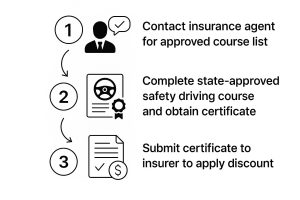
As you can see, it�s a logical flow from getting the right info to cashing in on your hard work.
After you send the certificate, don�t just sit back and assume it’s all handled. I always recommend following up with your agent about a week later. A quick call or email to confirm they received everything and processed the discount is all it takes. Be sure to ask when you should see the new, lower rate on your bill.
Remember: A little proactive communication goes a long way. A quick follow-up ensures your effort translates directly into savings without any administrative hiccups getting in the way.
By the way, these courses can sometimes help with ticket dismissal or point reduction, which also helps keep your rates down. If you’re wondering what your record looks like, our guide on how to check your driving record explains how to see what your insurer sees.
How to Choose the Right Safety Driving Course

When you’re ready to find a safety driving course, don’t just jump at the first Google result. To actually get that insurance discount, you have to pick a program that�s officially recognized by both your state’s DMV and your specific insurance provider.
Choosing the wrong one is a classic mistake. You could end up spending your time and money on a certificate that�s completely useless to your insurer. It’s like bringing a coupon for the wrong store�no matter how great the deal looks, it won’t get you anything at the checkout counter.
Online vs. In-Person: Which Is Best for You?
One of the first forks in the road you’ll encounter is whether to go with an online class or an in-person one. There are real pros and cons to each, so the best fit really comes down to your learning style, schedule, and how you prefer to get things done.
To help you decide, let’s break down the key differences between the two formats.
Online vs In-Person Safety Driving Courses
| Feature | Online Course | In-Person Course |
|---|---|---|
| Flexibility | High. Learn anytime, anywhere, at your own pace. | Low. Fixed schedule and location. |
| Cost | Generally more affordable. | Often more expensive due to overhead. |
| Learning Style | Ideal for self-starters and tech-savvy individuals. | Better for those who thrive on direct interaction and structure. |
| Interaction | Limited to email or chat support. | Direct Q&A with instructor and peer discussion. |
| Convenience | Complete from home, no travel required. | Requires commuting to a physical classroom. |
Ultimately, whether you choose the convenience of an online course or the structured environment of a classroom, one thing remains constant: the course must be approved.
Your primary goal is to find a course that�s not just convenient but also fully approved. An unaccredited online course is just as ineffective as an in-person class your insurer doesn�t recognize.
The Most Important Step: Verifying Approval
This is the golden rule for getting your safety driving course insurance discount: you absolutely must confirm the course is approved by two key organizations.
First, it has to be certified by your state�s Department of Motor Vehicles (DMV) or an equivalent licensing agency. Second, it must be on your specific insurance company�s list of accepted programs. This dual approval is completely non-negotiable.
Don’t skip this step. The whole reason insurers offer these discounts is based on this verification system. For instance, while nearly all states in the U.S. allow for these discounts, they only apply if the course meets strict state standards for reducing liability and collision coverage claims.
So, how do you make sure you get it right? Call your insurance agent. It�s the simplest, most direct way to get a list of providers they’ll accept. Many insurance companies even have a dedicated page on their website for this.
It�s also a good idea to cross-reference with a list of approved online traffic school options to see what accredited programs look like. Before you pay a dime, ask the course provider for proof of their state certification. Any legitimate school will have this information ready and will be happy to share it.
A Few Common Questions About Driving Course Discounts
When you’re thinking about taking a safety driving course to get an insurance discount, a few practical questions almost always pop up. It makes sense�you want to be sure the time and money you put in will actually pay off. We’ve pulled together the most common things people ask to give you straight, clear answers.
Think of this as your guide to the fine print, so you know exactly what to expect before you sign up.
How Long Is My Certificate Good For?
One of the first things drivers wonder is how long the savings from their hard work will stick around. Your course completion certificate isn’t a lifetime pass to a lower rate; it definitely has an expiration date in your insurer’s eyes.
Typically, a safety driving course insurance discount stays active on your policy for three years. While a few providers might go as long as five years, three is really the industry standard. Once that period is up, you’ll probably need to take a quick refresher course to keep the discount going. It’s their way of making sure your safe driving skills stay sharp.
Can I Still Get a Discount If I Have Points on My License?
This is a big one, and the answer really depends on your specific insurance company and why you have points in the first place.
Generally, having a few points on your license won’t automatically knock you out of the running for a discount. In fact, many insurers see you voluntarily taking a course as a huge plus�it shows you’re being proactive about improving your driving, and they’re happy to reward that. The situation gets a little different, though, if a court ordered you to take the class as part of a plea deal for a ticket.
If the course was mandatory to get a ticket dismissed or points removed, your insurer probably won’t offer a separate discount on top of that. In that scenario, the main benefit is keeping the violation off your record, which already saves you from a rate hike.
The best move is always to be upfront with your insurance agent. Just tell them what’s going on, and they can give you the correct information for your policy.
What Does a Defensive Driving Course Usually Cost?
The price tag for a defensive driving course can swing a bit depending on your state, who’s offering the class, and whether you do it online or in a classroom. That said, you can expect to pay somewhere in the ballpark of $25 to $100.
- Online Courses: These are almost always the most affordable choice, usually landing in the $25 to $50 range. They�re flexible and convenient, which helps keep their costs down.
- In-Person Courses: Sitting in a classroom tends to cost more, typically between $50 and $100. That higher price covers the physical location, the instructor’s time, and materials.
When you stack that one-time cost against a potential 5% to 20% discount on your annual premium, the course nearly always pays for itself within the first year.
Does the Discount Apply to My Entire Insurance Bill?
This is a detail that catches a lot of people by surprise. The discount you earn usually doesn’t come off your total insurance bill. Instead, it�s applied to very specific parts of your coverage.
More often than not, the discount is calculated on the premiums for these core coverages:
- Bodily Injury Liability: Covers injuries to other people if you cause an accident.
- Property Damage Liability: Pays for damage to someone else’s car or property.
- Collision Coverage: Covers damage to your own car from a crash.
The discount usually won’t touch your comprehensive coverage (which handles things like theft, hail damage, or vandalism) or other add-ons. So, while it might not slash your total bill by a full 10%, it still adds up to real savings on the most expensive parts of your policy.
Ready to become a safer driver and start saving? At BDISchool, we offer Florida’s state-approved Basic Driver Improvement course, fully online and designed for your convenience. Eliminate points, reduce fines, and unlock your insurance discount today. Enroll now at BDISchool and take the first step toward a cleaner record and lower rates.

